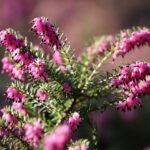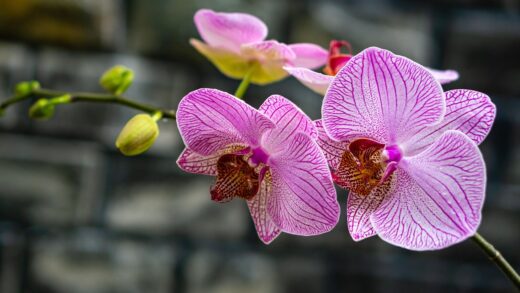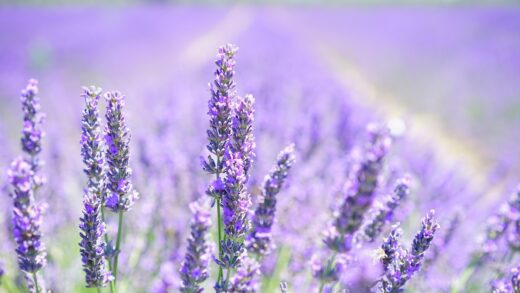While German irises are known for their robust and resilient nature, they are not entirely immune to the challenges posed by various diseases and pests. Proactive management and good cultural practices are the cornerstones of keeping these problems at bay, as prevention is always more effective than treatment. The most significant threats to iris health, namely bacterial soft rot and the iris borer, are often linked to suboptimal growing conditions such as poor drainage, overcrowding, and improper sanitation. By understanding the life cycles of these adversaries and the conditions that favor them, a gardener can create an environment that promotes strong, healthy irises that are naturally more resistant to attack.
The most feared disease among iris growers is bacterial soft rot, caused by the bacterium Erwinia carotovora. This pathogen turns the firm, healthy tissue of the rhizome into a soft, foul-smelling mush, leading to the collapse of the leaf fan at its base. The bacteria typically gain entry through some form of wound, which can be caused by cultivation tools, insect damage (particularly from the iris borer), or natural splitting. The disease is most prevalent in warm, wet conditions, making overwatering and poor drainage the primary contributing factors. Vigilance and swift action are required at the first sign of this destructive disease.
On the pest front, the single most destructive enemy is the iris borer (Macronoctua onusta). The adult is a nocturnal moth, but its larval stage is what causes severe damage. The borer caterpillar hatches in the spring and tunnels its way through the iris leaves down into the rhizome, where it hollows out the interior as it feeds. This tunneling activity not only damages the rhizome directly but also creates entry points for the dreaded bacterial soft rot. The presence of the borer is often the precursor to a fatal rot infection, making its control a top priority for maintaining a healthy iris planting.
Other common issues include fungal diseases such as leaf spot and rust, which, while not usually fatal, can disfigure the foliage and weaken the plant over time by reducing its photosynthetic capacity. These diseases are favored by humid weather and poor air circulation. Good garden hygiene, including the removal of infected leaves and proper spacing of plants, can significantly reduce their incidence. By combining attentive observation with sound horticultural practices, the majority of disease and pest problems can be managed effectively, ensuring the long-term beauty and health of the German iris.
Proactive strategies for disease and pest prevention
The most effective approach to managing iris diseases and pests is to focus on prevention through good cultural practices. This begins with selecting the right planting location. A site with full sun and excellent drainage is paramount, as sunlight acts as a natural sanitizer, and well-drained soil prevents the waterlogged conditions that foster rot-causing pathogens. Ensuring proper spacing between rhizomes, typically 30-60 centimeters apart, promotes good air circulation, which allows foliage to dry quickly after rain and reduces the likelihood of fungal diseases taking hold.
Meticulous garden sanitation is another cornerstone of preventative care. Throughout the growing season, it is important to promptly remove and destroy any leaves that show signs of disease or pest damage. In the autumn, after the first hard frost has killed the foliage, a thorough cleanup is essential. All dead leaves and other garden debris should be cut back and removed from the iris bed. This is critical because the eggs of the iris borer are laid on this old foliage, and many fungal spores overwinter in the plant debris. Removing this material breaks the life cycle of these pests and pathogens.
Maintaining plant vigor is a key defensive strategy. A healthy, robust iris is better able to withstand and recover from pest attacks and disease pressures than a weak, stressed one. This means providing the correct balance of nutrients, avoiding high-nitrogen fertilizers that create soft, vulnerable growth, and watering appropriately. Over-fertilized and over-watered plants are prime targets. Additionally, dividing overcrowded clumps every three to five years not only rejuvenates the plants but also provides an opportunity to inspect the rhizomes for any signs of trouble and to remove any compromised sections.
Finally, regular inspection is a simple but vital proactive measure. By taking the time to look closely at the iris foliage and rhizomes throughout the season, a gardener can catch problems in their earliest stages when they are much easier to control. Look for the tell-tale signs of iris borer entry, such as dark streaks or notched leaf edges in the spring. Feel the base of the leaf fans for any unusual softness that might indicate the beginnings of rot. Early detection allows for targeted intervention before a small issue escalates into a major infestation or a widespread disease outbreak.
Common fungal diseases
Fungal leaf spot, often caused by the fungus Didymellina macrospora, is one of the most common diseases to affect German iris foliage. The symptoms typically appear after the flowering period, especially during spells of warm, humid, or rainy weather. It manifests as small, circular to oval-shaped spots on the leaves, which are initially yellowish and later turn grayish-brown with a distinct dark or reddish border. While the spots are primarily a cosmetic issue, a severe infection can cause the leaves to die back prematurely, which reduces the plant’s ability to photosynthesize and store energy for the following year.
The key to managing fungal leaf spot is to reduce the conditions that favor its development. Since the fungus thrives on moisture, improving air circulation is the most effective control measure. This involves ensuring plants are not overcrowded and keeping the surrounding area free of weeds. It is also important to water at the base of the plant using a soaker hose or drip irrigation rather than overhead sprinklers, as this keeps the foliage dry. If the disease appears, removing and destroying the affected leaves can help to slow its spread. A thorough autumn cleanup is crucial, as the fungus overwinters on dead plant material.
Rust is another fungal disease that can occasionally affect irises, caused by fungi in the Puccinia genus. It appears as small, reddish-brown pustules, typically on the undersides of the leaves. When these pustules are rubbed, they release a rusty-colored powder, which are the fungal spores. Like leaf spot, rust is favored by high humidity and is generally not a fatal disease, but it can weaken the plant if left unchecked. The management strategies are the same: promote good air circulation, keep foliage dry, and practice good garden sanitation by removing infected leaves and cleaning up debris in the fall.
In severe cases of either leaf spot or rust, or in gardens where these diseases are a persistent annual problem, the use of a fungicide may be considered. A copper-based fungicide or other products labeled for the control of fungal diseases on ornamental plants can be effective if applied as a preventative measure before the disease typically appears or at the very first sign of infection. It is important to follow the manufacturer’s instructions for application rates and timing carefully. However, for most home gardeners, focusing on cultural controls is a more sustainable and often sufficient long-term strategy.
Bacterial infections to watch for
Bacterial soft rot stands as the most destructive disease that can afflict German irises. Caused by Erwinia carotovora, this pathogen rapidly decomposes the plant’s tissues, particularly the rhizome. The first visible symptom is often the sudden yellowing and collapse of a central leaf fan, which may pull away from the rhizome with a gentle tug. At the base of the collapsed fan, the rhizome itself will be soft, water-soaked, and mushy, and will emit a characteristically foul, putrid odor. The infection can spread with alarming speed, especially in warm and wet weather, and can quickly destroy an entire clump.
The bacteria responsible for soft rot are widespread in garden soil but can only infect the plant through a wound. These entry points can be created by a variety of means, including damage from shovels or cultivators, splits in the rhizome from natural growth, frost cracks, or, most commonly, the tunneling activity of the iris borer. This is why iris borer control is so intimately linked with the prevention of soft rot. Once inside the rhizome, the bacteria multiply rapidly, producing enzymes that dissolve the cell walls and lead to the characteristic soft, rotting texture.
If soft rot is detected, immediate and decisive action is required to save the plant and prevent the spread of the disease. The infected clump must be dug up without delay. Using a clean, sharp knife, all of the soft, mushy, and discolored tissue must be ruthlessly cut away until only firm, healthy, white or yellowish rhizome remains. This process is akin to a surgical procedure. After excising the rot, it is a common practice to treat the cut surfaces of the remaining healthy rhizome. This can be done by dusting them with a scouring powder containing bleach or by dipping them in a 10% bleach solution (one part bleach to nine parts water) and then allowing them to dry completely in the sun for several days before replanting in a new, well-drained location.
Preventing bacterial soft rot is centered on eliminating the conditions that favor it. This means ensuring impeccable drainage, planting rhizomes shallowly with the tops exposed, avoiding high-nitrogen fertilizers, and controlling the iris borer population. It is also crucial to be careful when cultivating around the plants to avoid wounding the rhizomes. By maintaining a dry, airy environment around the rhizomes and minimizing potential entry points for the bacteria, the risk of this devastating disease can be significantly reduced.
Identifying and managing the iris borer
The iris borer is the most formidable insect pest of German irises, not only for the direct damage it causes but also for its role as a vector for bacterial soft rot. The life cycle begins in late summer and early autumn when the adult, a non-descript nocturnal moth, lays its eggs in clusters on old iris leaves and other garden debris near the base of the plants. These eggs overwinter and hatch the following spring, typically in April or May, when the new iris leaves are about 10-15 centimeters tall.
The newly hatched larvae are tiny caterpillars that immediately begin to crawl up the iris leaves. They enter the leaf tissue, often near the top, and start to tunnel downwards as they feed. This early stage of infestation can be identified by looking for tell-tale signs on the leaves, such as dark, watery-looking streaks, or leaves that have notched or ragged edges. As the caterpillar grows, it continues its journey down through the leaf fan and eventually reaches the rhizome by early summer. It is at this point that the most severe damage occurs, as the borer chews and tunnels through the rhizome, hollowing it out from the inside.
Management of the iris borer must be multi-pronged and timed to interrupt its life cycle. The single most effective organic control method is a thorough autumn cleanup. By cutting back and destroying all old iris foliage after a hard frost, the overwintering eggs are removed from the garden, preventing them from hatching the following spring. This one task can dramatically reduce the borer population. In the spring, regular inspection of the new foliage for the early signs of larval activity is crucial. If watery streaks are observed, the leaf can be squeezed firmly between thumb and forefinger to crush the small caterpillar inside.
For established infestations, other measures may be necessary. During the summer, if a fan of leaves suddenly wilts or yellows, it is a strong indication that a borer is active in the rhizome below. The clump should be dug up, and the rhizome inspected. The borer, which by this time will be a large, pinkish-white caterpillar, can often be located and physically removed and destroyed. Any damaged parts of the rhizome should be cut away. In cases of severe, persistent infestations, systemic insecticides can be applied in the spring, timed to coincide with the hatching of the larvae, but these should be used as a last resort and with careful consideration of their impact on beneficial insects.
Other common pests and their control
While the iris borer is the most serious threat, several other pests can occasionally trouble German irises. Aphids, for example, are small, sap-sucking insects that can congregate in colonies on the leaf fans and flower buds. They feed by piercing the plant tissue and extracting the nutrient-rich sap, which can cause distortion of the leaves and flowers. A heavy infestation can weaken the plant, and the sticky “honeydew” they excrete can lead to the growth of sooty mold. Aphids are usually easy to control with a strong jet of water from a hose, which will dislodge them, or by applying insecticidal soap.
Slugs and snails can also be a nuisance, particularly in damp, shady conditions. They are most active at night or on overcast days and feed on the foliage and sometimes the flowers, leaving behind ragged holes and their characteristic slime trails. While they rarely cause fatal damage, they can be a significant cosmetic problem. Control methods include setting out slug traps (such as shallow dishes of beer), using commercially available slug baits (iron phosphate baits are a safer option for pets and wildlife), or creating barriers of coarse material like crushed eggshells or diatomaceous earth around the plants.
Spider mites are tiny arachnids that can become a problem during hot, dry weather. They are difficult to see with the naked eye, but their presence is often indicated by a fine webbing on the leaves and a stippled, silvery, or bronzed appearance of the foliage. They feed by sucking the contents out of individual plant cells. Like aphids, they can be controlled by a strong spray of water, which disrupts their colonies, or with applications of insecticidal soap or horticultural oil. Increasing the humidity around the plants by misting can also help to deter them.
Thrips are another type of tiny, sap-sucking insect that can cause damage to both the foliage and the flowers. Their feeding can result in silvery streaks on the leaves and can cause flower buds to be deformed or fail to open properly. Thrips are notoriously difficult to control, but removing and destroying infested flowers and leaves can help to reduce their numbers. In severe cases, systemic insecticides may be required, but encouraging natural predators like lacewings and ladybugs by maintaining a diverse garden environment is a more sustainable long-term strategy for managing these and other minor pests.


















